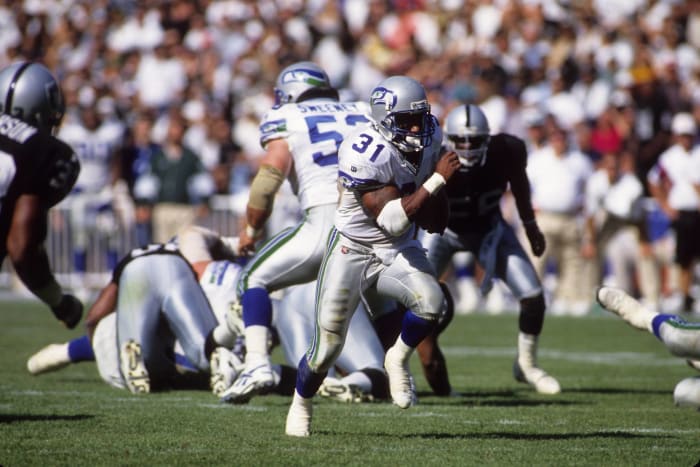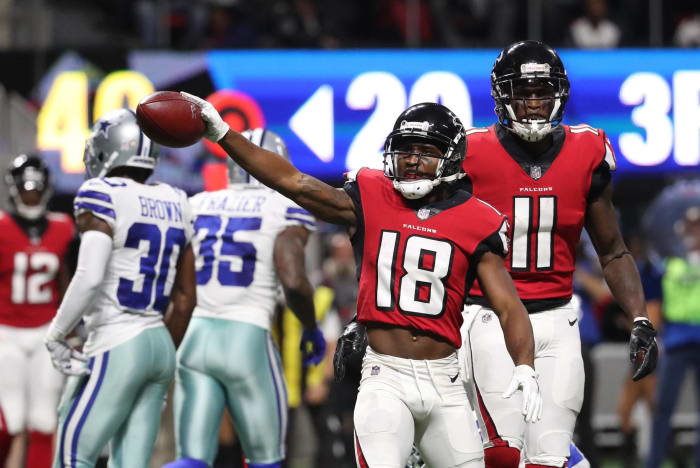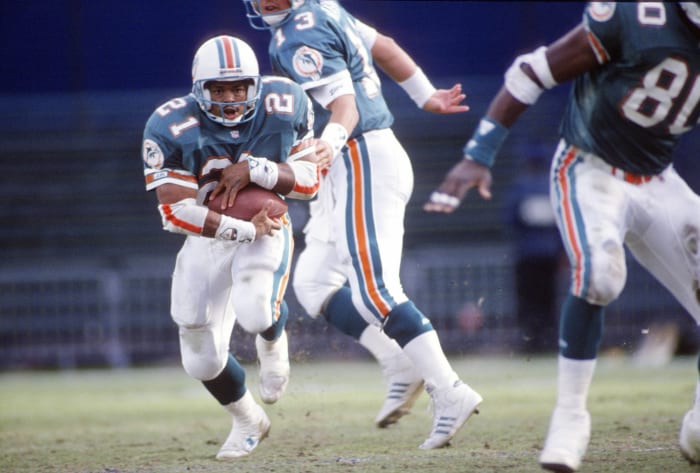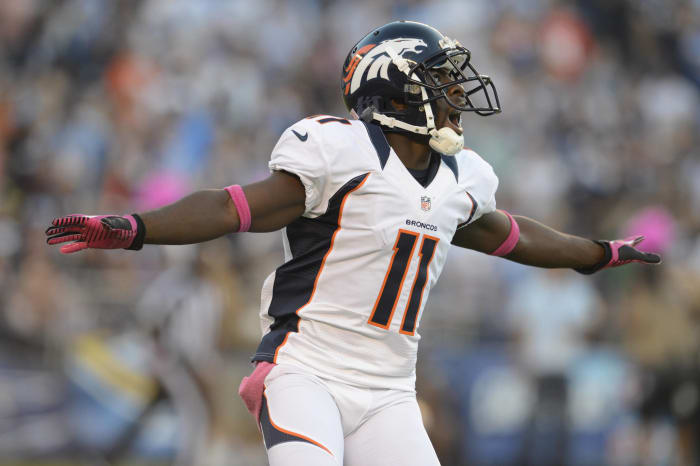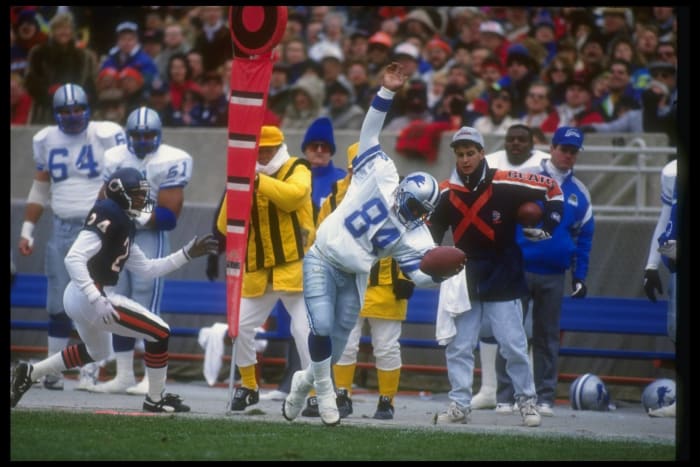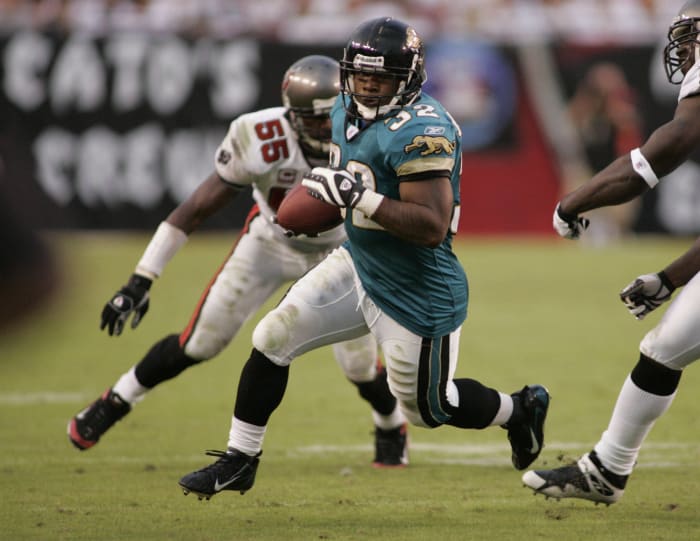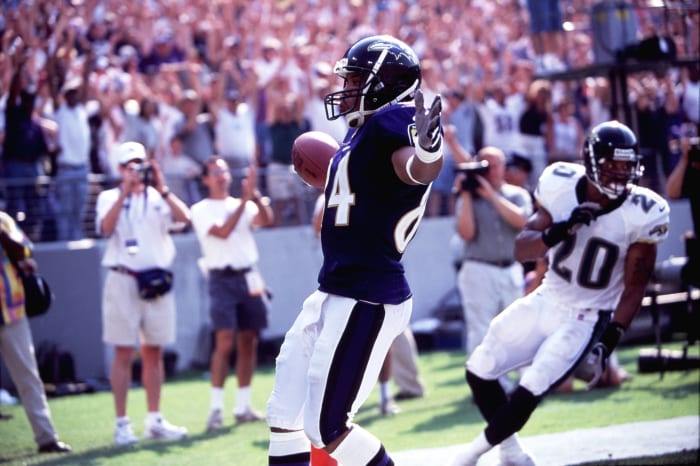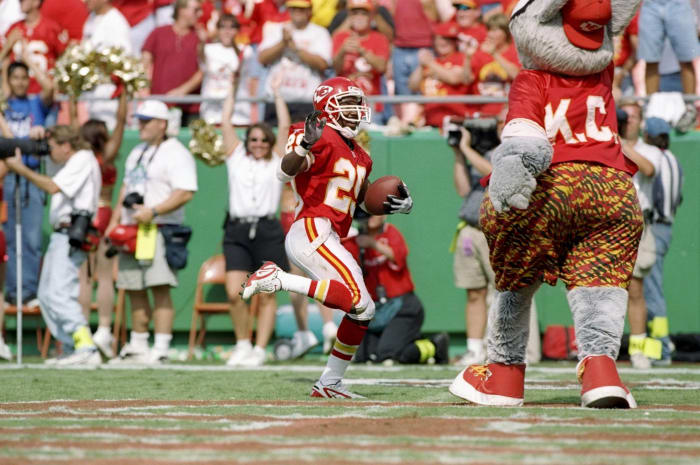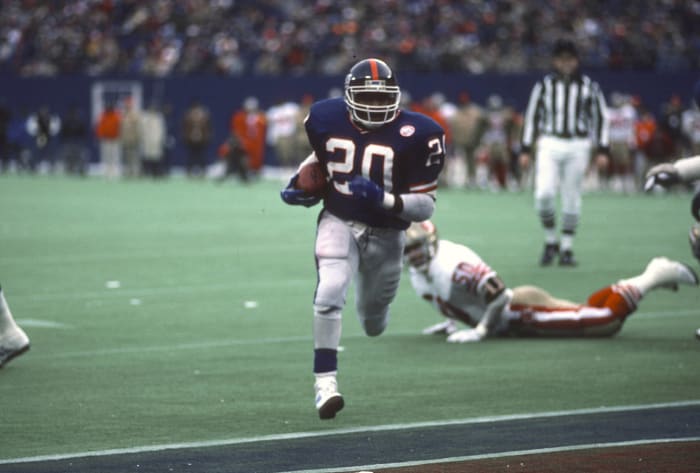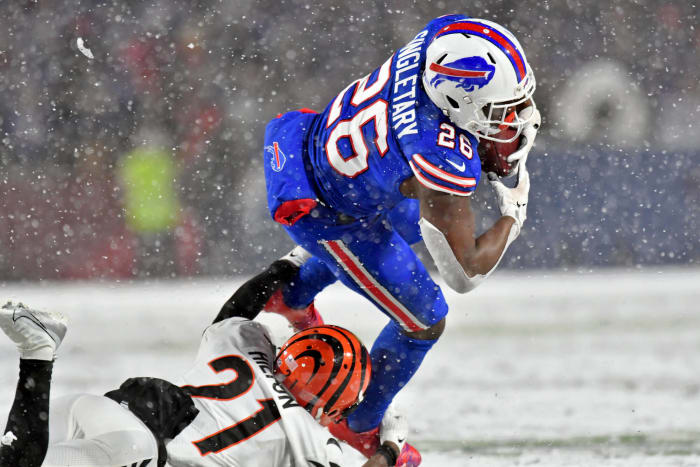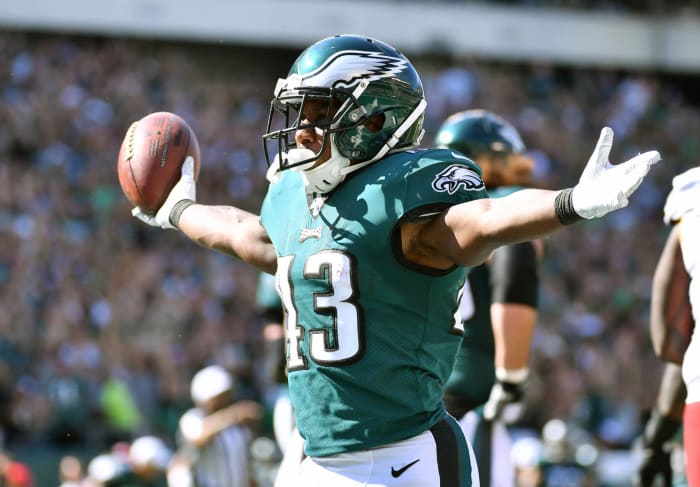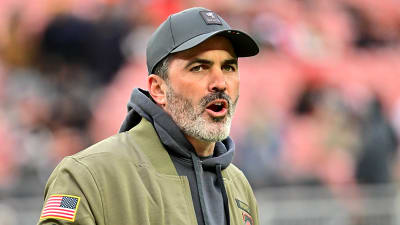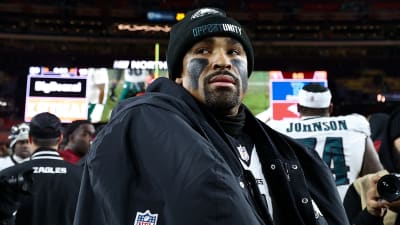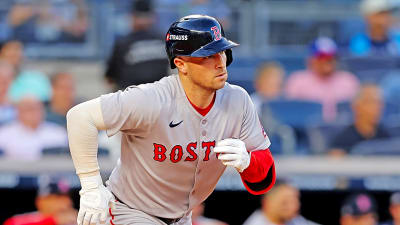Few players in NFL history at or below the 5-foot-7 threshold have been major contributors. Here are the top undersized cogs, among those who play contact positions (non-kickers and punters), who broke through to make an impact despite their height limitations.
George Rose/Getty Images
Of the 5-foot-7-and-under contingent, Broussard's NFL entrance and longevity stand out. The Falcons chose the 5-7, 201-pound back in the 1990 first round. The compact running back went off the board three picks after Emmitt Smith and three picks before Rodney Hampton. While Broussard did not extend the underrated line of 1980s Falcon running backs (William Andrews, Gerald Riggs, John Settle) into the '90s, he played nine seasons and was a key contributor on the 1991 Falcons' playoff team. He later teamed with Chris Warren in a talented Seahawks backfield in the late '90s.
Mike De Sisti-USA TODAY Sports
Despite his 5-foot-6, 191-pound frame, Cohen immediately carved out a role for the Bears and became one of the NFL's most electric players. The shifty running back complemented Jordan Howard in Chicago's backfield and outshined the starter in 2018, totaling 1,169 scrimmage yards -- including 725 through the air, aiding Mitch Trubisky's outlier season -- despite a mere 21% snap rate. Cohen earned All-Pro acclaim for his punt-return work that season, which snapped an eight-year Bears playoff drought, and led to a nice extension from the Bears. Cohen signed a three-year, $17.25 million extension in 2020, but injuries have sidetracked his career.
Jason Getz-USA TODAY Sports
During the Browns' radical 2016 rebuild effort, they let standout O-linemen Alex Mack and Mitchell Schwartz walk. Later that year, they also cut Gabriel, who had shown promise as a rookie in 2014. The 5-foot-7 slot receiver followed Kyle Shanahan to Atlanta, after the disgruntled Cleveland OC escaped his Browns contract, and became a quality target for an elite offense. Gabriel's 579-yard, six-TD 2016, as a Julio Jones support staffer, helped the Falcons score 540 points (eighth all-time) and reach Super Bowl LI. Gabriel then joined Cohen on the Bears' inclusive 2018 aerial corps that secured an NFC North title.
Jasen Vinlove-USA TODAY Sports
Few modern return men can match Grant's explosiveness. While the Dolphins have not given the Texas Tech product a chance to replicate his college work as a wideout often, Grant has delivered in both return roles. The 5-7 specialist has five career return TDs -- three on punts -- and spent nearly six seasons with the Dolphins. Grant's 2020 punt-return TD assisted in the Dolphins' upset of the Rams, Tua Tagovailoa's first NFL victory. Grant's contributions earned him a $6 million-per-year contract, which is quite lavish for a player who largely contributes on special teams. Miami traded Grant to Chicago during the 2021 season, and injuries kept him out in 2022 and '23.
Focus on Sport/Getty Images
In the heart of a run-heavy NFL decade, Herron delivered one of the most impressive pound-for-pound seasons in league history. The Patriots gave their 5-foot-5, 170-pound tailback 269 touches in 1974. Herron turned them into 1,298 scrimmage yards and 12 TDs. Add that to his kick- and punt-return work and Herron totaled a then-NFL-record 2,444 all-purpose yards. Even after the 16-game era, that ranks 11th all time. The CFL import also led the NFL in kick-return yards as a rookie in 1973. The ex-college sprint champion outrushed all-time Pats rushing leader Sam Cunningham in '74, with the disparate duo combining for 1,635 yards.
Focus on Sport/Getty Images
The Dolphins of Dan Marino's time were not known for their rushing attacks. In fact, Miami had one 1,000-yard rusher (Karim Abdul-Jabbar) in Marino's 17 seasons. But Higgs was the only other Miami back to clear 900 rushing yards in that span. The former eighth-round Cowboys draftee did so twice. A former Plan B free-agent pickup, Higgs operated as Miami's starting back in 1991 and '92 and broke out quickly with back-to-back 100-yard games to start that tenure. He combined for 1,820 rushing yards and 11 TDs in those seasons, the latter producing an AFC East crown over the Bills. The 5-7 back lasted eight NFL seasons.
Matt A. Brown/Icon Sportswire
One of the fastest players in NFL history, Holliday made a major impact on Peyton Manning's Broncos teams. The ex-LSU sprinter ran a 10-flat 100 meters, qualified for the 2007 world championships , and beat Olympic bronze medalist Walter Dix before focusing on football. Between October 2012 and September 2013, Holliday ripped off a Devin Hester-ian stretch by producing six return TDs (three kickoffs, three punts). Holliday delivered two of these in the same game. with the Denver secondary's infamous gaffe obscuring the 5-5 speedster's monster 2012 divisional-round effort. Fumbling issues stopped Holliday's Denver run at two seasons, but he made the time count.
Owen Shaw/Getty Images
During the first half of Bo Jackson's Auburn career, the athletic marvel teamed with a 5-foot-6 back to form a dynamic rushing attack. Despite barely weighing 170 pounds, James became a fifth-round Chargers pick in 1984. A year later, the "Little Train" delivered one of the best receiving seasons in running back history. Dan Fouts' tiny outlet back caught 86 passes for 1,027 yards. James added 516 on the ground, including an OT walk-off against the Raiders. James could not replicate his 1985 masterpiece, but he played five NFL seasons and remains one of just four running backs to cross the 1,000-yard receiving barrier.
George Rose/Getty Images
Johnson's best work came in the USFL, and he started for just two NFL seasons. But he thrived in the rival league and helped introduce the NFL to the Run and Shoot offense. Playing under Run and Shoot godfather Mouse Davis with the Houston Gamblers, Johnson combined for a staggering 218 catches, 2,839 yards, and 29 TDs in two seasons. His 115 grabs in 1984 set a pro football record, but the USFL folding led Johnson to a programming job at IBM. As Lions OC in 1989, Davis summoned his 5-7 pupil. Despite nearly three years away, Johnson dropped a 1,000-yard season in '89. This included a 248-yard game against the Saints.
Bettmann/Getty Images
As the Broncos assembled their "Orange Crush" defense, they drafted the likes of Randy Gradishar, Tom Jackson, and Louis Wright. But a few of Denver's '70s defenses included a 15th-round pick from the 1973 draft. Jones made a rare foray from late-round pick to immediate starter as a rookie; he made a rarer voyage considering he stood 5-foot-7. Like Rondale Moore, Jones was listed at 5-9 in college. But he intercepted nine passes over his first two seasons, making a name for himself as the Broncos built their storied defense. While Jones was not on Denver's 1977 Super Bowl team, he lasted longer as a starting defender than almost anyone sub-5-8.
Chris Livingston/Icon Sportswire
His 5-foot-7 listing aside, Jones-Drew brought explosiveness that made him rather difficult to corral. Teaming with Fred Taylor to form a dominant Jaguars backfield, the 2006 second-round pick roared out of the blocks by scoring 15 TDs as a rookie. Jones-Drew's 166 rushing yards and three total TDs against the Colts that year prompted some early obituaries for the eventual champions, and the UCLA alum played nine seasons. Jones-Drew won the 2011 rushing title with 1,606 yards and amassed three 1,300-yard seasons on Jags teams that did not feature much receiving talent to keep defenses honest.
John Iacono/SI/Icon Sportswire
Drafted in the Ravens' inaugural 1996 class, which brought Jonathan Ogden and Ray Lewis to Baltimore, Lewis became one of his era's top return men. The 5-foot-7 ex-Maryland Terrapin totaled eight return touchdowns (seven on punts) in his nine-year career. He returned two punts for scores during the 1997, '98, and 2000 regular seasons, the latter work sample assisting an offensively limited (but rather defensively capable) Ravens team to Super Bowl XXXV. Lewis' most famous return is certainly the kickoff he took back in that game, burying the Giants after they notched a kick-return score and punctuating a Ravens rout.
Stephen Dunn/Allsport/Getty Images
McMillian's career might not receive enough attention. Despite playing in an era in which the big-bodied wide receiver became commonplace, the 5-foot-7, 154-pound cornerback lasted eight seasons and spent most of that time as a starter. "Mighty Mouse" started 81 games for the Eagles, Saints, Chiefs, and 49ers in the 1990s, making his top contributions in Philadelphia and Kansas City. Chosen in the 10th round in the final year that round existed (1992), McMillian started for three Eagles teams. He signed with the Chiefs in 1997 and played a central role for their No. 1-ranked defense, intercepting eight passes and returning three for TDs.
John Betancourt/Getty Images
Mouse Davis' no-height-restrictions Houston Gambler squads, quarterbacked by Jim Kelly, featured an array of future NFL wideouts. Richard Johnson, Ricky Sanders, and Clarence Verdin emerged as NFL starters, but McNeil rose to prominence first. Joining Johnson and Verdin as 1,000-yard receivers on the 1985 USFL squad, McNeil notched two return TDs as a Browns rookie in 1986. McNeil seldom played receiver, with his 5-foot-7, 145-pound frame interfering, but the "Ice Cube" -- a nickname that spawned shortly after William Perry's "The Refrigerator" moniker -- made the 1987 Pro Bowl. McNeil played four Browns seasons, suiting up for three AFC title games.
Focus on Sport/Getty Images
Bill Parcells did not employ size discrimination when building his second Giants Super Bowl squad, using 5-foot-8 wideout Stephen Baker and 5-7 scatback Meggett. A fifth-round pick out of Division I-AA, Meggett became an immediate contributor as a Phil Simms outlet option and a returner. To close out his second season, Meggett supplemented Super Bowl XXV MVP Ottis Anderson with 11 offensive touches for 66 yards to help keep the Bills offense off the field. The elusive playmaker struggled with fumbles (45 in 10 seasons) but notched eight career return TDs and later traveled with Parcells to the Patriots and Jets.
Focus on Sport/Getty Images
Parcells' Giants were known for physicality, but before Meggett, the Hall of Fame coach gave another short performer a big role. Morris entered the NFL as a higher-end prospect, a second-round pick out of Syracuse, and Parcells gave him the keys to the Giants' ground attack in 1984. In 1985 and '86, the 5-foot-7 back broke out and became one of the NFL's best ball carriers. Morris made back-to-back Pro Bowls those years, combining for 2,852 rushing yards and 36 TDs. Morris gashed the 49ers for 159 yards in a 49-3 Round 2 romp en route to the Giants' first Super Bowl win. A 1989 foot injury cut short an underrated prime.
17 of 21
Devin Singletary
Mark Konezny-USA TODAY Sports
Josh Allen has been the most reliable runner during the Bills' recent resurgence, but Singletary also proved valuable. After a dominant final season at Florida Atlantic, the 2019 third-round pick became the Bills' top running back during much of the Allen era. The 5-foot-7 back ripped off consecutive 800-yard rushing seasons for AFC East-winning Bills teams in 2021 and '22, and after a crowded RB free agent market netted Singletary only a $1.77 million deal, led the 2023 Texans in rushing. Singletary took over as Houston's starter, amassing a career-high 898 yards and helping C.J. Stroud pilot the team to a surprise playoff berth.
Denny Medley-USA TODAY Sports
A Chiefs team packed with future Hall of Famers received notable contributions from the AFL's smallest player. Known as "Super Gnat," the 5-foot-5, 154-pound Smith became a return weapon in Kansas City. A sixth-round pick out of Tennessee State, Smith led the AFL in kick-return yards as a rookie in 1967. Smith's 106-yard return in 1967 remains a Chiefs record, and his career 26.1 yards per kick return ranks 26th in NFL history. Smith made transactional history, too, becoming the first player traded from the AFL to the NFL. The Chiefs sent him to the 49ers after two seasons and change.
Eric Hartline-USA TODAY Sports
The do-it-all threat lasted 15 seasons in the NFL, dazzling as a return man and enjoying a productive career as a running back. The 5-foot-6 dynamo thrived with the Chargers, Saints, and Eagles, compiling nine return touchdowns -- including four after age 30 in Philly, en route to three straight Pro Bowls. Sproles helped the best iteration of the Drew Brees Saints offense, totaling 1,313 scrimmage yards and nine TDs to help the Saints set the single-season yardage record in 2011. He peaked in the 2008 wild-card round in San Diego. Sproles' 328 all-purpose yards, including a 22-yard OT walk-off run, powered the 8-8 Bolts past the 12-4 Colts. That total sits third in playoff history.
Joe Robbins/Getty Images
Tolar meets the height criteria here, but at nearly 200 pounds, the Oilers fullback certainly did not have little-man responsibilities. A Steelers draft pick the Oilers later scooped up, Tolar earned the "Human Bowling Ball" nickname due to his bulldozing style. He played seven seasons in Houston, being part of a stacked Oilers skill-position corps that included standout wideouts Charlie Hennigan and Bill Groman and highly drafted running back Billy Cannon. Tolar made two AFL All-Star teams and surpassed 1,000 rushing yards in 1962 when Houston qualified for its third straight AFL Championship Game.
Bettmann/Getty Images
Easily one of the NFL's most unique players, Young managed a nine-year career despite standing 5-foot-4 and checking in at less than 170 pounds. Even for the era in which he played (1947-55), Young's frame jumped out. Young played for the All-American Football Conference's New York Yankees then jumped to the NFL's New York Yanks (not the same franchise) before ending his career with the Colts. Operating in a Sproles-like all-purpose capacity, though in a far more violent game, Young dizzied defenders often and ended his career with a 4.6 yards-per-carry average and 44 total TDs (six on returns).
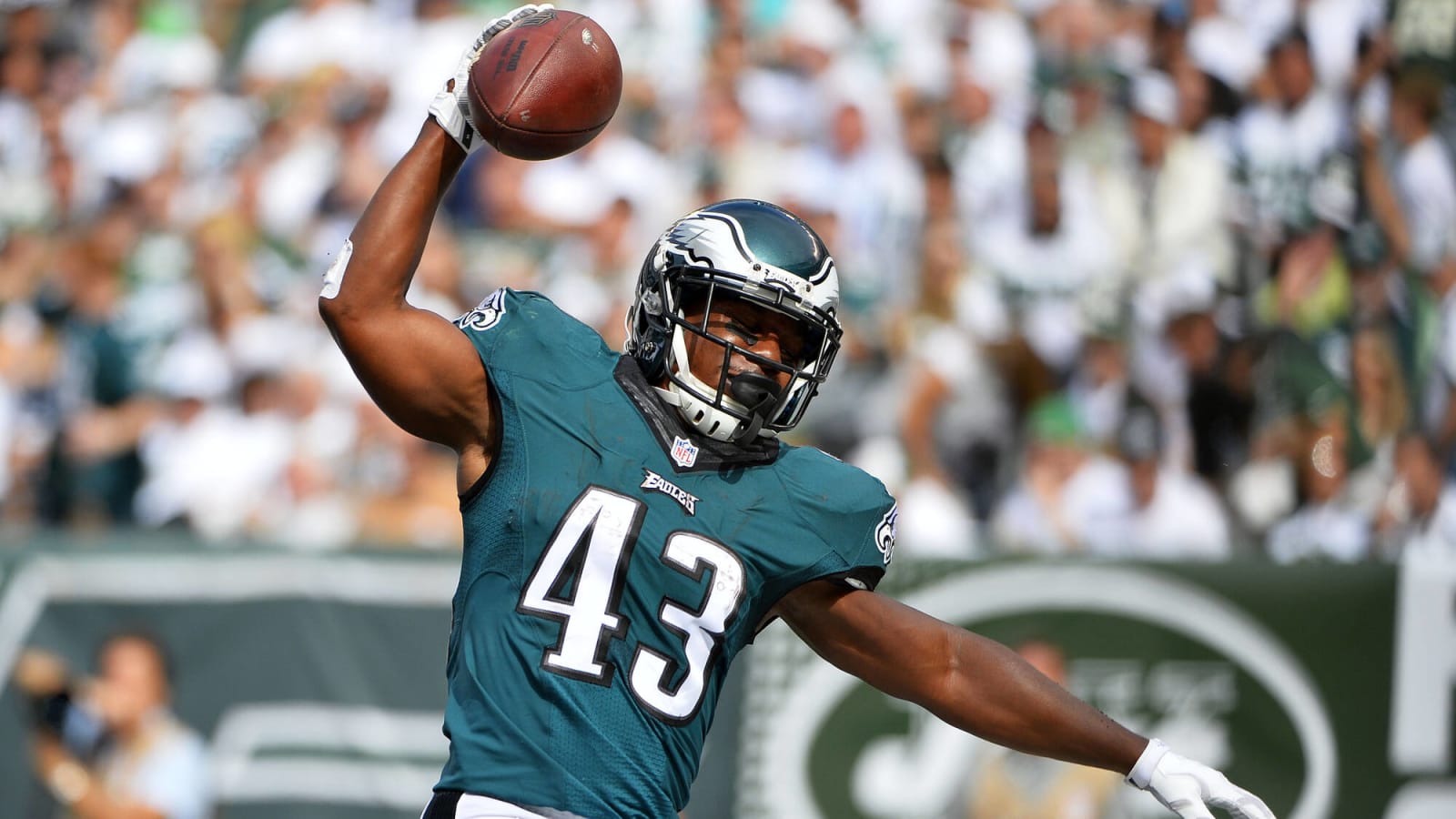
 +
+
